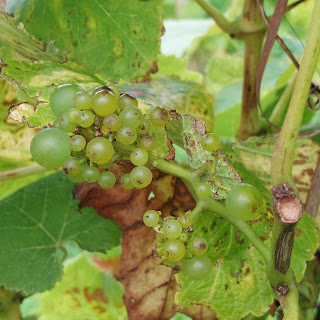 |
| Shrivelled grapes |
We couldn't harvest yesterday because Alex had to show Ross House with little notice. We had a lot of commitments this week, and I hadn't looked at the grapes in two days. I thought it would give more of them a chance to reach a brix of 20 as they were hovering around 19 three days ago.
When we started picking the Rondo this morning, it quickly became apparent that we'd had a crop failure. Without rain for so long, in those two days, most of them turned into raisins. I was gutted. We only had a few good bunches. Very tasty, but hardly enough for a bottle or two.
 |
| A good bunch |
 |
| The full harvest of Rondo. |
Meanwhile, the Solaris also reached veraison. We picked what was there -- so little for the number of vines -- but our yield was barely half a bucket. Lots of hens and chicks but really tasty and sweet. Most were from the younger vines not the older ones. I just don't understand what went wrong. There was no early frost or major storms.
You can see the damage to the foliage caused by the drought. The only good news is that the birds didn't eat all of the grapes. Our strategies must have worked:
- Kites flying overhead
- Heron on the ground
- CDs fluttering around the vines
- No bird food in the garden for the last two months
- Cats prowling far and wide
Curiously, some of the vines are flowering again. They are really confused by this late warmth and sunshine.
 |
| Flowering Solaris |
 |
| Flower buds on Rondo |
 |
| Vines suffering from drought |

The Pinot Noir is encouraging
|
Veraison is beginning
|
 |
| Chardonnay still hard as a rock and sour |
 |
| Veraison not evident |
 |
| Hens and chicks |
 |
| No transparency |
 |
| Visiting honey bees |
 |
| The vineyard vista is still magnificent |
Farming during anthropogenic climate weirdness is going to be a challenge.
.png)























.png)




.png)
.png)






.png)
.png)











